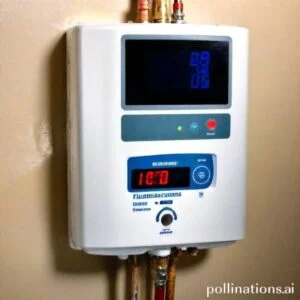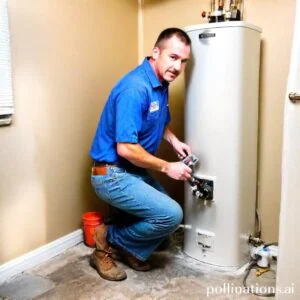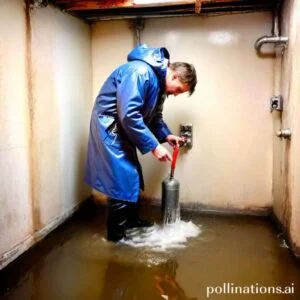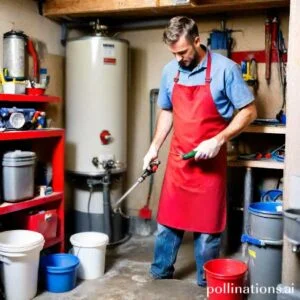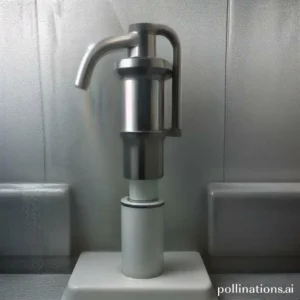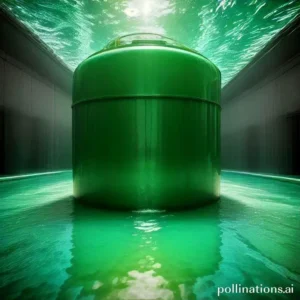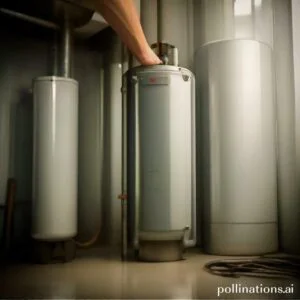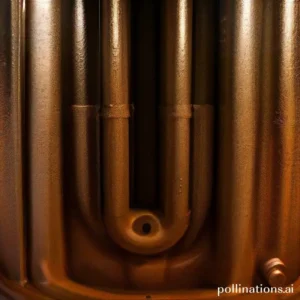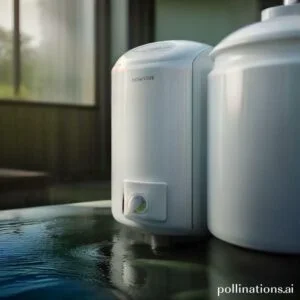
II. Sediment buildup in the tank can cause excessive noise during operation.
III. Flushing should be done annually to maintain optimal performance and reduce noise.
Flushing is a common maintenance practice for water heaters that can significantly affect noise levels. By flushing the water heater, sediment and debris are removed, preventing them from causing noise and potential damage to the unit.
Flushing also helps to improve the overall efficiency and performance of the water heater, ensuring hot water is readily available when needed. Whether you have a traditional tank water heater or a tankless system, regular flushing is essential to maintain a quieter and more efficient operation.
Causes of Water Heater Noise
1. Sediment buildup
One common cause of water heater noise is sediment buildup. Over time, minerals and debris can accumulate at the bottom of the tank, causing a layer of sediment to form. This sediment can create a popping or rumbling sound when the water is heated. Regular maintenance, such as flushing the tank to remove the sediment, can help prevent this issue.
2. Mineral deposits
Mineral deposits can also contribute to water heater noise. When water is heated, minerals like calcium and magnesium can precipitate out and form deposits on the heating element or the interior of the tank. These deposits can create a knocking or banging sound. Regular descaling or using a water softener can help reduce mineral buildup and minimize noise.
3. Corrosion
Corrosion can cause water heater noise as well. When the metal components of the heater, such as the anode rod or the tank itself, start to corrode, it can result in a variety of sounds. These can include hissing, sizzling, or even a popping noise. Proper maintenance, including regular inspection and replacement of corroded parts, can help prevent excessive noise due to corrosion.
4. Loose or damaged components
Loose or damaged components within the water heater can also be a source of noise. For example, a loose heating element or a malfunctioning thermostat can cause clicking or humming sounds. Inspecting the heater and tightening or replacing any loose or damaged parts can help resolve these issues and reduce noise.
5. High water pressure
High water pressure can put stress on the water heater system, leading to noise. The pressure can cause pipes to vibrate or water to rush through the system at a higher velocity, resulting in banging or whistling sounds. Installing a pressure regulator or reducing the overall water pressure can help alleviate this problem.
| Cause | Noise |
|---|---|
| Sediment buildup | Popping or rumbling |
| Mineral deposits | Knocking or banging |
| Corrosion | Hissing, sizzling, or popping |
| Loose or damaged components | Clicking or humming |
| High water pressure | Banging or whistling |
The Flushing Process
1. Preparing the Water Heater for Flushing
To effectively flush your water heater, it is crucial to prepare it beforehand. This step ensures optimal results and helps maintain the longevity of your appliance. Start by turning off the power supply or gas to the water heater. This will prevent any accidents or damage during the flushing process. Additionally, locate the cold water shut-off valve and close it to stop the incoming water flow.
2. Draining the Tank
Once you have prepared the water heater, it’s time to drain the tank. Attach a garden hose to the drain valve at the bottom of the tank and place the other end in a suitable draining area, such as a floor drain or outside. Open the drain valve and allow the water to flow out of the tank. This step removes sediment and mineral buildup that can affect the efficiency of your water heater.
3. Flushing the Tank
After draining the tank, it’s essential to flush it thoroughly to remove any remaining debris. To do this, close the drain valve and turn on the cold water supply valve. This will allow fresh water to enter the tank and flush out any remaining sediment. Keep the cold water supply valve open until the water runs clear from the drain hose, indicating that the tank is free from debris.
4. Refilling the Tank
Once the tank is flushed, it’s time to refill it. Close the drain valve and remove the hose. Open the cold water supply valve fully to allow the tank to fill up. Take caution and ensure that there are no leaks or drips from the connections. It’s crucial to let the tank fill completely before moving to the next step.
5. Restarting the Water Heater
With the tank refilled, it’s time to restart the water heater. If you turned off the power supply, turn it back on and follow the manufacturer’s instructions for relighting the pilot light if necessary. For electric water heaters, simply switch the power back on. Allow the water heater to heat the newly filled tank to the desired temperature, and you’re ready to enjoy a continuous supply of hot water.
Benefits of Flushing
Flushing your water heater regularly offers numerous advantages that can optimize its performance, increase energy efficiency, extend its lifespan, reduce maintenance costs, and improve water quality.
Improved Water Heater Performance
Increased Energy Efficiency
A water heater that is free from sediment buildup operates more efficiently, requiring less energy to heat water. Flushing your water heater regularly can help remove this buildup, allowing it to function at its highest efficiency. This can result in energy savings and lower utility bills.
Extended Lifespan of the Water Heater
Sediment and mineral accumulation can lead to corrosion and damage to the internal components of a water heater. By regularly flushing the water heater, you can prevent or minimize the buildup, reducing the risk of damage and extending the lifespan of the appliance. This can save you money on premature replacement costs.
Reduced Maintenance Costs
Flushing your water heater can help prevent costly repairs and maintenance. Sediment buildup can cause issues such as clogged valves, decreased water flow, and malfunctioning heating elements. By flushing the water heater, you can prevent these problems, reducing the need for repairs and maintenance services.
Enhanced Water Quality
Over time, sediment and mineral deposits can affect the quality of the water coming from your water heater. Flushing the water heater helps to remove these deposits, resulting in cleaner and fresher hot water. This can be particularly beneficial for households that rely on well water or have hard water, as flushing can help improve taste and reduce unpleasant odors.

Flushing Frequency
Factors that determine flushing frequency
Regular flushing of a water heater is essential to maintain its efficiency and extend its lifespan. The frequency of flushing depends on several factors:
- Water quality: Hard water with high mineral content tends to cause sediment buildup more quickly, requiring more frequent flushing.
- Water usage: Homes with high water usage or large families may need more frequent flushing to prevent sediment accumulation.
- Type of water heater: Different types of water heaters, such as tankless or traditional tank heaters, may have varying flushing requirements.
Recommended flushing frequency
In the course of the exact flushing frequency may vary depending on the factors mentioned above, it is generally recommended to flush your water heater at least once a year. This regular maintenance helps remove sediment and mineral buildup, improving the heater’s efficiency and preventing potential issues.
Signs that indicate the need for flushing
It’s important to pay attention to signs that indicate the need for flushing your water heater. These signs may include:
- Decreased hot water supply: If you notice a decrease in the amount of hot water available, it could be a sign of sediment accumulation that is reducing the tank’s capacity.
- Noisy operation: Excessive noise coming from the water heater can be an indication of sediment buildup, which affects the efficiency and increases noise levels.
- Rusty water: If you see rusty or discolored water coming from your hot water taps, it could be a sign of corrosion or sediment accumulation inside the tank.
Regular flushing of your water heater not only helps maintain its performance but also reduces the risk of damage and extends its lifespan. By complying with the recommended flushing frequency and paying attention to signs that indicate the need for flushing, you can ensure the optimal operation of your water heater and enjoy reliable hot water supply.
| Flushing Frequency | Recommended | Factors to Consider |
|---|---|---|
| Once a year | Water quality | Hard water |
| Water usage | High water usage or large families | |
| Type of water heater | Tankless or traditional tank heaters |

DIY vs Professional Flushing
Touching on flushing, whether you choose to do it yourself (DIY) or hire a professional, there are pros and cons to consider. In this section, we will scrutinize the benefits of both options and discuss factors to consider when making your decision.
Pros and Cons of DIY Flushing
DIY flushing can be a cost-effective option for those who are comfortable with tackling home maintenance tasks. Here are some pros and cons to keep in mind:
- Pros:
- Cost savings: By doing the flushing yourself, you can save money on hiring a professional.
- Flexibility: You can schedule the flushing at your convenience, without having to wait for an appointment.
- Learning experience: DIY flushing allows you to gain hands-on knowledge and experience.
- Cons:
- Time-consuming: Flushing can be a time-consuming process, especially if you are not familiar with the steps involved.
- Risk of mistakes: Without proper knowledge and expertise, there is a risk of making mistakes that could lead to further issues.
- Limited equipment: You may not have access to specialized equipment that professionals use for efficient flushing.
- Expertise: Professionals have the knowledge and experience to ensure thorough and effective flushing.
- Efficiency: With specialized equipment and techniques, professionals can complete the flushing process efficiently.
- Peace of mind: By hiring a professional, you can have confidence that the flushing is done correctly, reducing the risk of future issues.
- Budget: Assess your budget and determine if hiring a professional fits within your financial means.
- Time: Consider how much time you are willing to invest in flushing and weigh it against the convenience of hiring a professional.
- Expertise: Evaluate your own knowledge and skills to determine if you have the expertise to perform a successful flush.
- Type of system: Some flushing tasks may require specific equipment or expertise that only professionals can provide.
Benefits of Professional Flushing
Meanwhile DIY flushing has its advantages, there are also compelling reasons to consider hiring a professional:
Factors to Consider
When deciding between DIY and professional flushing, consider the following factors:
Bottom Line
Flushing your water heater is an important maintenance task that can help reduce noise levels and extend the life of your appliance. Over time, sediment and mineral buildup can cause your water heater to work harder and make more noise. Flushing removes these deposits and restores your water heater’s efficiency. Despite this, it’s important to follow the manufacturer’s instructions and safety guidelines when flushing your water heater. If you’re not comfortable doing it yourself, consider hiring a professional plumber. Regular flushing can also help prevent leaks and other issues that can lead to costly repairs. By taking care of your water heater, you can enjoy hot water and a quieter home for years to come.
Read More:
1. What Precautions Should I Take Post-Flushing?
2. Diy Flushing For Improved Water Heater Efficiency
